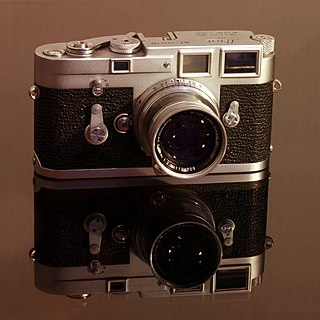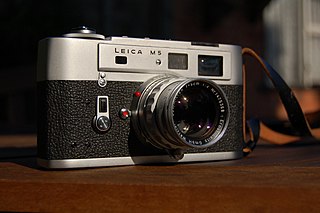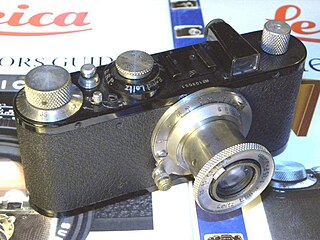The Canon rangefinders of the late 1940s and early 1950s are Leica-compatible screw-mount cameras. Many were brought to the U.S. by servicemen who bought them while visiting Japan during the Korean War. Typically these were mounted with a 50mm Serenar (later, Canon) lens.
Many of these can still be used, and are similar in function to the Leica III. The top speed is 1/500. Some models are flash synchronized, using Canon's side-rail synch contacts. The lens mount is compatible with all standard Leitz M39 mount lenses
The original ones came with a spring-loaded takeup spool that most photographers found easier to use than the one provided by Leica—many are now missing the spool since the spools were taken for use in Leica cameras.
Unlike many Leica copies, quality control and finish are fully up to Leitz standards.
The noticeable difference between The Canon and other LTM (leica thread mount) rangefinders is the angled cornered casing.
Where the Canon cameras surpass the Leica is the finder. Viewfinder and rangefinder are integrated, and a three-way switch allows a view for 50mm, 100mm, and critical rangefinder use. This arrangement made the viewfinders on Canon II/III/IV cameras tend to be dimmer and less brilliant than their counterparts found in Leica or other Barnack-style copy cameras.

A rangefinder camera is a camera fitted with a rangefinder, typically a split-image rangefinder: a range-finding focusing mechanism allowing the photographer to measure the subject distance and take photographs that are in sharp focus. Most varieties of rangefinder show two images of the same subject, one of which moves when a calibrated wheel is turned; when the two images coincide and fuse into one, the distance can be read off the wheel. Older, non-coupled rangefinder cameras display the focusing distance and require the photographer to transfer the value to the lens focus ring; cameras without built-in rangefinders could have an external rangefinder fitted into the accessory shoe. Earlier cameras of this type had separate viewfinder and rangefinder windows; later the rangefinder was incorporated into the viewfinder. More modern designs have rangefinders coupled to the focusing mechanism so that the lens is focused correctly when the rangefinder images fuse; compare with the focusing screen in non-autofocus SLRs.

Leica Camera AG is a German company that manufactures cameras, lenses, binoculars, rifle scopes, microscopes and ophthalmic lenses. The company was founded by Ernst Leitz in 1869. The name Leica is derived from the first three letters of his surname (Leitz) and the first two of the word camera: lei-ca.

Zorki is the name of a series of 35mm rangefinder cameras manufactured in the Soviet Union between 1948 and 1978.

Minolta Co., Ltd. was a Japanese manufacturer of cameras, camera accessories, photocopiers, fax machines, and laser printers. Minolta was founded in Osaka, Japan, in 1928 as Nichi-Doku Shashinki Shōten. It is perhaps best known for making the first integrated autofocus 35 mm SLR camera system. In 1931, the company adopted its current name, an acronym for "Mechanism, Instruments, Optics, and Lenses by Tashima". In 1933, the brand name first appeared on a camera, a copy of the Plaubel Makina simply called "Minolta".

Cosina Co., Ltd. is a manufacturer of high-end optical glass, optical precision equipment, cameras, video and electronic related equipment, based in Nakano, Nagano Prefecture, Japan.

A digital single-lens reflex camera is a digital camera that combines the optics and the mechanisms of a single-lens reflex camera with a digital imaging sensor.

Contax began as a camera model in the Zeiss Ikon line in 1932, and later became a brand name. The early cameras were among the finest in the world, typically featuring high quality Zeiss interchangeable lenses. The final products under the Contax name were a line of 35 mm, medium format, and digital cameras engineered and manufactured by Kyocera, and featuring modern Zeiss optics. In 2005, Kyocera announced that it would no longer produce Contax cameras. The rights to the brand are currently part of Carl Zeiss AG, but no Contax cameras are currently in production, and the brand is considered dormant.

The Leica M3 is a 35 mm rangefinder camera by Ernst Leitz GmbH, introduced in 1954. It was a new starting point for Leitz, which until then had only produced screw-mount Leica cameras that were incremental improvements to its original Leica (Ur-Leica). The M3 introduced several features to the Leica, among them the combination of viewfinder and rangefinder in one bright window, like on the Contax II, a bayonet lens mount, and rapid film advance lever. It was the most successful model of the M series, with over 220,000 units sold by the time production of the M3 model ended in 1966.

The FED is a Soviet rangefinder camera, mass-produced from 1934 until around 1996, and also the name of the factory that made it.

The M39 lens mount is a screw thread mounting system for attaching lenses to 35 mm cameras, primarily rangefinder (RF) Leicas. It is also the most common mount for Photographic enlarger lenses.
Walter Mandler was a famous lens designer of Ernst Leitz Canada in Midland, Ontario.

The Leica CL is a 35mm compact rangefinder camera with interchangeable lenses in the Leica M-mount. It was developed in collaboration with Minolta who manufactured it. It first appeared in April 1973 and was released in the Japanese market in November 1973 as the Leitz Minolta CL. Both the Leica CL and Leitz Minolta CL were manufactured in a new Minolta factory in Osaka. In 2017, Leica announced a new digital mirrorless camera, again named Leica CL.

The Leica III is a rangefinder camera introduced by Leica in 1933, and produced in parallel with the Leica II series. Several models were produced over the years, with significant improvements.

The Leica M2 is a 35 mm rangefinder camera by Ernst Leitz GmbH of Wetzlar, Germany, introduced in 1957. Around 82,000 M2s were produced between 1957 and 1968. Around 1500 M2s were produced by Ernst Leitz Canada, but most of these are not marked as such on the top plate.

The Konica Hexar RF is a 35 mm rangefinder camera which was sold by Konica. It was introduced to the market on 13 October 1999. and subsequently discontinued some time before the end of 2003. The camera used the "Bayonet Konica KM-mount", a copy of the Leica M-mount, thus sharing interchangeable lenses with those designed for Leica cameras and others compatible with them. The Hexar RF has a combined rangefinder/viewfinder modeled on that of Leica cameras, a similar body shape and size - and so is similar to Leica M-mount cameras in many aspects of operation.

The Leica II is a rangefinder camera introduced by Leica in 1932. They were the first Leica cameras with a built-in rangefinder. Several models were produced over the years, in parallel with the Leica III series from 1933.

The Leica M5 is a 35 mm camera by Leica Camera AG, introduced in 1971. It was the first Leica rangefinder camera to feature through-the-lens (TTL) metering and the last to be made entirely in Wetzlar by hand using the traditional "adjust and fit" method.

The Leica Standard, Model E was the fourth version of the original 35 mm Leica camera to be launched from Ernst Leitz in Wetzlar, Germany. The concept was conceived by their employee Oskar Barnack in 1913. Production of the camera began in 1925 but it was not until the end of the decade that it was perfected and full-scale production was established.

The Leica copies originate from the Leica camera that was launched by Ernst Leitz, Wetzlar in 1925, using the Leica 39mm screw mount of 25 threads per inch, and the standard 35mm film. The design was carried out by Oskar Barnack, beginning in 1913 by building a camera for 24×36 mm negatives that by now is called the Ur-Leica; but Ernst Leitz did not decide to manufacture it until 1924. Once started, the Leica production volume doubled each year; in 1929, some 16.000 cameras were produced. In 1930, an improved model with interchangeable lens was introduced, followed a year later by the fully developed Leica II with standardized film to lens flange distance, and in 1932 the basic Leica Standard; the Leica concept was established. This camera's features are the basis for defining a Leica copy.

The Leicaflex was the first series of 35 mm format Single-lens reflex (SLR) cameras manufactured by Leitz Camera. The Leicaflexes were fully mechanical cameras marketed between 1964 and 1976, in response to the rapid increase in popularity and usability of SLRs during this period. Their appeal was limited by their failure to keep pace with the state of the art in SLR design, their somewhat limited selection of accessories, and their extremely high price in comparison with their Japanese competitors. They were ultimately replaced by the R series Leicas developed by Leitz with the assistance of Minolta under a cooperation agreement between the two companies.



















